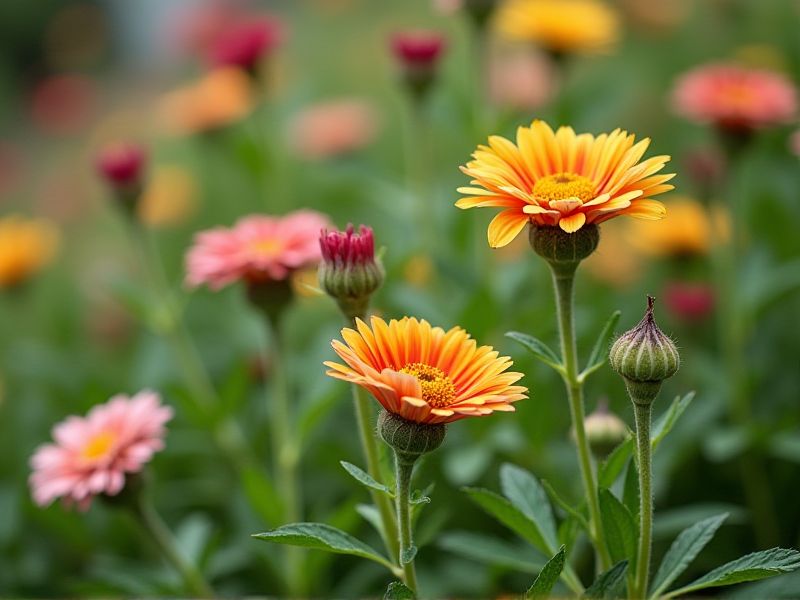
Drought-tolerant plants, such as succulents and Mediterranean herbs, thrive in arid conditions and require minimal watering, making them perfect for water-wise gardens. Varieties like Agave, Sedum, and Lavender not only conserve water but also add aesthetic value with their unique shapes and vibrant colors. When selecting compact plants for your garden, consider options like dwarf conifers or alpine flowers that enhance visual interest while minimizing maintenance. These plants are often adapted to retain moisture in their leaves, helping them flourish even in dry environments. By incorporating drought-tolerant options, you can create a sustainable landscape that reduces your water consumption.
List of some Compact plants that are drought-tolerant
- Lavender (Lavandula)
- Succulent (Various genera)
- Yarrow (Achillea millefolium)
- Coneflower (Echinacea)
- Russian Sage (Perovskia atriplicifolia)
- Blanket Flower (Gaillardia)
- Lamb's Ear (Stachys byzantina)
- Rockrose (Cistus)
- Sedum (Sedum)
- Rosemary (Rosmarinus officinalis)
Important things about Compact plants that are drought-tolerant
Water Efficiency
Compact drought-tolerant plants offer remarkable water efficiency, making them ideal for sustainable gardening and landscape design. These resilient species, such as succulents and native perennials, thrive in arid conditions, requiring minimal irrigation once established. By incorporating these plants into your garden, you reduce water usage while enhancing aesthetic appeal and biodiversity. Selecting drought-tolerant options not only conserves resources but also supports local ecosystems, promoting a balanced environment.
Minimal Space Requirements
Compact plants that are drought-tolerant are ideal for small gardens or urban spaces where water conservation is essential. Varieties such as succulents, sedums, and dwarf varieties of native plants thrive with minimal watering while still providing vibrant color and texture. These plants not only reduce water usage but also attract beneficial pollinators like bees and butterflies, enhancing the local ecosystem. Incorporating compact, drought-tolerant plants into your landscape design can create an attractive, low-maintenance garden that conserves resources and promotes sustainability.
Low Maintenance Needs
Compact plants that are drought-tolerant require minimal maintenance while offering aesthetic appeal to your garden. Varieties such as succulents, dwarf ornamental grasses, and certain native shrubs thrive in arid conditions, making them ideal choices for water-conservative landscapes. These resilient plants often possess adaptations like thick leaves or deep root systems that allow them to survive extended dry periods. By incorporating drought-tolerant compact plants into your landscaping, you can create a beautiful, eco-friendly garden that reduces water consumption and maintenance efforts.
Variety Of Species
Compact drought-tolerant plants include a range of species that thrive in arid conditions while requiring minimal water. Examples such as Sedum, Echeveria, and Sempervivum showcase succulent characteristics that store moisture, making them ideal for rock gardens or low-maintenance landscapes. Ornamental grasses like Blue Fescue or Dwarf Fountain Grass add texture and movement while also needing little irrigation. By choosing these resilient plants, you can create a sustainable garden that conserves water and flourishes even in dry climates.
Adaptability To Different Climates
Compact plants that are drought-tolerant thrive in a variety of climates, making them ideal for water-conscious gardeners. Species such as succulents and native drought-resistant perennials demonstrate remarkable resilience, requiring minimal irrigation once established. Their ability to conserve moisture through specialized adaptations, such as thickened leaves and deep root systems, enables them to flourish in arid environments. By incorporating these efficient plants into your landscape, you not only reduce water usage but also create a sustainable and visually appealing garden.
Natural Pest Resistance
Compact plants often feature natural pest resistance due to their dense growth habits, which can deter pests from easily accessing the foliage. These drought-tolerant varieties, such as succulents and some types of ornamental grasses, thrive in arid conditions, minimizing the need for chemical pesticides. You may find that these resilient plants not only conserve water but also attract beneficial insects that further enhance garden health. By incorporating compact, drought-tolerant species into your landscape, you support sustainable gardening practices while enjoying vibrant, pest-resistant plants.
Can Improve Soil Health
Compact plants that are drought-tolerant play a vital role in improving soil health by enhancing its structure and retaining moisture. These resilient species, such as Sedum, Portulaca, and Lantana, are ideal for arid climates, promoting biodiversity while minimizing water usage. By developing deep root systems, they prevent soil erosion and encourage nutrient cycling, ultimately leading to enriched soil composition. Incorporating these plants into your garden design not only conserves water but also fosters a thriving ecosystem.
Aesthetic Appeal
Compact plants that are drought-tolerant not only enhance your garden's aesthetic but also contribute to sustainable landscaping. Varieties like succulents, such as Echeveria and Haworthia, offer unique shapes and vibrant colors while requiring minimal water. Ornamental grasses, like Blue Oat Grass or Dwarf Fountain Grass, bring texture and movement, making your outdoor space visually dynamic. Choosing these resilient plants allows you to create a beautiful and low-maintenance garden that thrives in dry conditions.
Pollinator-Friendly
Choosing compact, drought-tolerant plants enhances your garden's sustainability while supporting pollinators. Varieties such as Sedum and Echinacea thrive in arid conditions, attracting bees and butterflies with their vibrant blooms. These resilient plants conserve water while providing essential habitat and food sources for beneficial insects. Incorporating Native species like Salvia and Agastache not only adds color but also encourages biodiversity in your outdoor space.
Long Lifespan
Compact plants that are drought-tolerant, such as succulents and certain types of ornamental grasses, are perfect for gardens and indoor spaces where water conservation is essential. These resilient species, like Sempervivum and Delosperma, thrive with minimal water while adding aesthetic value to your landscape. Their rugged adaptations, including thickened leaves and deep root systems, allow them to withstand extended dry periods, making them ideal for xeriscaping. By incorporating these low-maintenance plants into your garden, you create a sustainable environment that not only conserves water but also enhances biodiversity.
